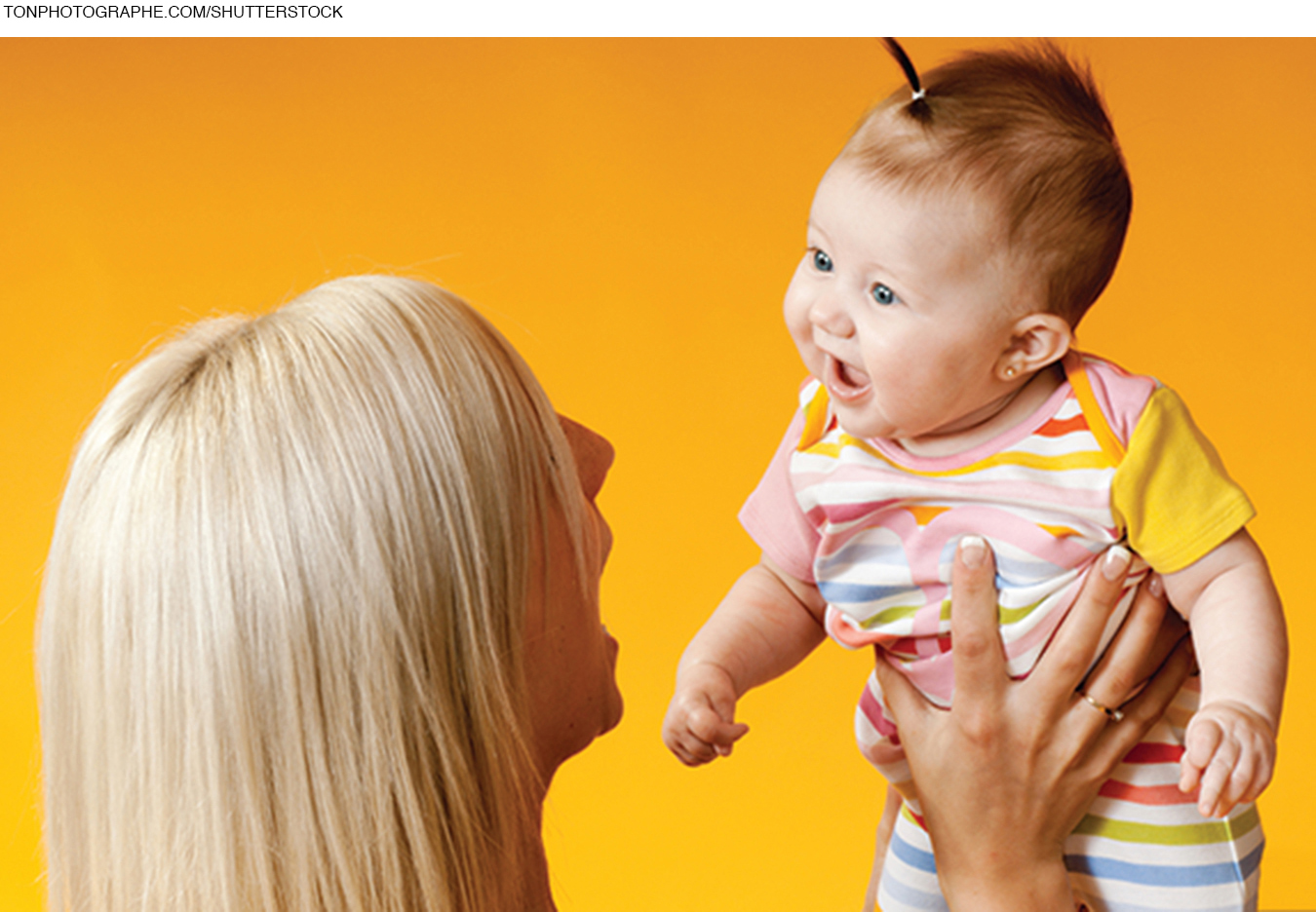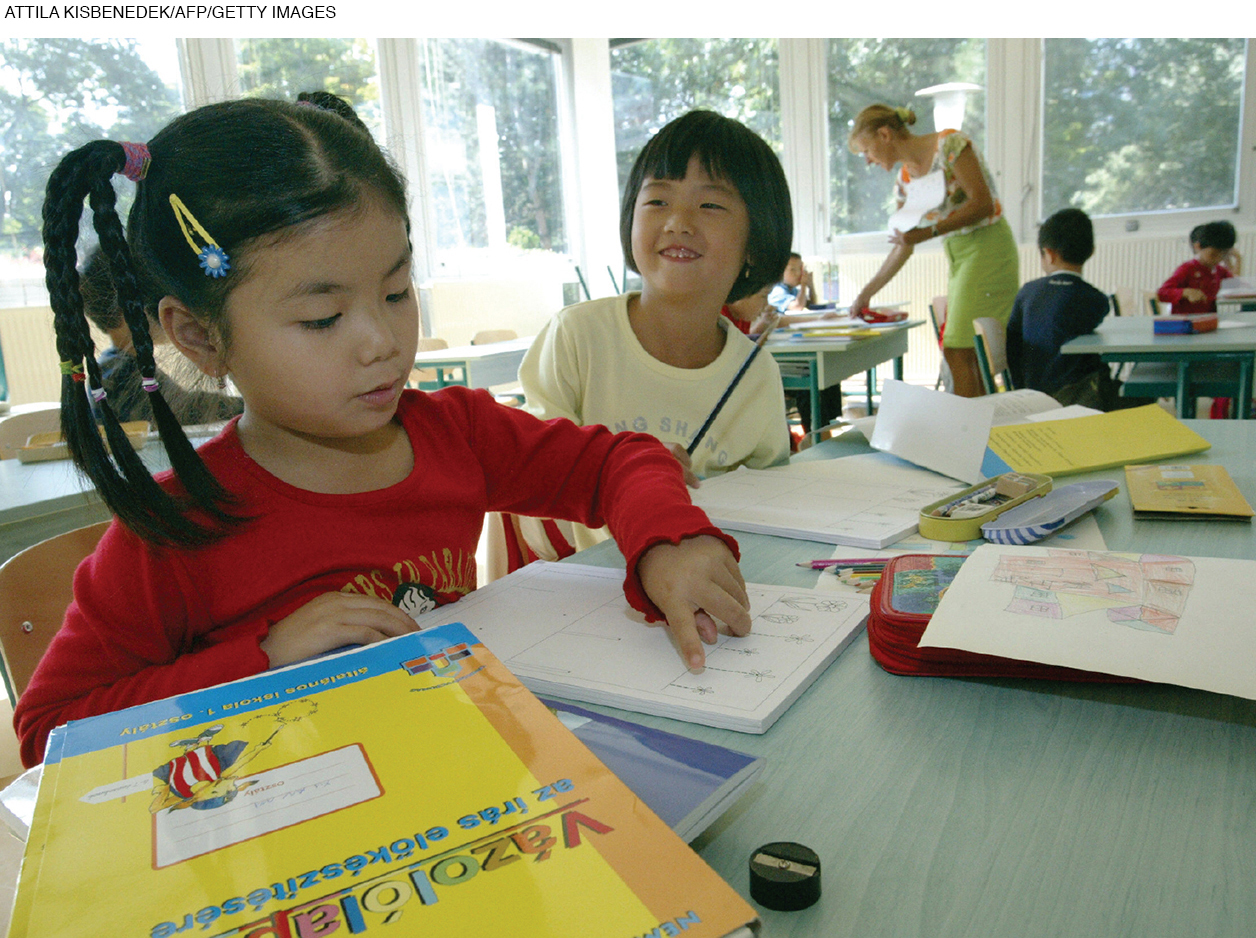Language Learning


Video Activity: Language Acquisition in Young Children features video clips of a new sign language created by deaf Nicaraguan children and provides insights into how language evolves.
182
Brain maturation, myelination, scaffolding, and social interaction make early childhood ideal for learning language. Young children are language sponges; they soak up every verbal drop they encounter, mastering vocabulary and grammar at a rapid pace.
Preoperational thinking—
The Vocabulary Explosion
The average child knows about 500 words at age 2 and more than 10,000 at age 6 (Herschensohn, 2007). That’s more than six new words a day. These are averages. Estimates of vocabulary size at age 6 vary from 5,000 to 30,000.
Estimates vary because it is hard to know how many words a child understands, in part because some tests of vocabulary are more stringent than others (Hoffman et al., 2013). For example, after children listened to a book about a raccoon that saw its reflection in the water, they were asked what reflection means. Which of these five answers is correct?
THINK CRITICALLY: What standard should be used to decide which of these five children knew the vocabulary word?
“It means that your reflection is yourself. It means that there is another person that looks just like you.”
“Means if you see yourself in stuff and you see your reflection.”
“Is like when you look in something, like water, you can see yourself.”
“It mean your face go in the water.”
“That means if you the same skin as him, you blend in” (Hoffman et al., 2013, pp. 471–
472).
| Approximate Age | Characteristic or Achievement in First Language |
|---|---|
| 2 years |
Vocabulary: 100– Sentence length: 2– Grammar: Plurals; pronouns; many nouns, verbs, adjectives Questions: Many “What’s that?” questions |
| 3 years |
Vocabulary: 1,000– Sentence length: 3– Grammar: Conjunctions, adverbs, articles Questions: Many “Why?” questions |
| 4 years |
Vocabulary: 3,000– Sentence length: 5– Grammar: Dependent clauses, tags at sentence end (“… didn’t I?” “… won’t you?”) Questions: Peak of “Why?” questions; many “How?” and “When?” questions |
| 6 years |
Vocabulary: 5,000– Sentence length: Some seem unending (“… and … who … and … that … and …”) Grammar: Complex, depending on what the child has heard, with some children correctly using the passive voice (“Man bitten by dog”) and subjunctive (“If I were …”) Questions: Some about social differences (male– |
183
In the same study, when a story included “a chill ran down his spine,” children were asked what chill meant. One child answered, “When you want to lay down and watch TV—
fast-
The speedy and sometimes imprecise way that children learn new words by quickly categorizing them.
FAST-
Language mapping is not precise. For example, children rapidly connect new animal names to already-

Picture books offer many opportunities to advance vocabulary through scaffolding and fast-
This process explains some vocabulary errors. For example, 2-
WORDS AND THE LIMITS OF LOGIC Closely related to fast-
184
Bilingual children who don’t know a word in the language they are speaking often insert a word from the other language. That mid-
Some English words are particularly difficult for any child—
Extensive study of children’s language abilities finds that fast-
Acquiring Grammar
Remember from Chapter 3 that grammar includes structures, techniques, and rules that communicate meaning. That makes grammar essential for speaking, reading, and writing well.
BRAIN AND BASICS As soon as they start speaking, children use basic grammar, first in holophrases and then in combining words. For example, English-
Children apply rules of grammar as soon as they figure them out. They use their own theories about how language works and use their personal experiences regarding when various rules apply (Meltzoff & Gopnik, 2013).
For example, toddlers learn to add s to form the plural, asking for cookies, blocks, and so on. Soon children add an s to make the plural of words they have never heard before. If preschoolers are shown a drawing of an abstract shape, told it is called a wug, and then shown two of these shapes, they say there are two wugs (Berko, 1958).
overregularization
Applying rules of grammar even when exceptions occur, making the language seem more “regular” than it actually is.
Children apply the rules of grammar when they should not. This error is called overregularization. By age 4, many children overregularize that final s, talking about foots, tooths, and mouses. This signifies knowledge, not ignorance. They are smart enough to apply the rules of grammar (Ramscar & Dye, 2011). The child who says, “I goed to the store” needs to hear, “Oh, you went to the store?” rather than criticism.
pragmatics
The practical use of language, adjusting communication according to audience and context.
More difficult to learn is an aspect of language called pragmatics—knowing which words, tones, and grammatical forms to use with whom (Siegal & Surian, 2012). In some languages, it is essential to know which set of words to use when a person is older or not a close friend or family member, or even which grandparents are their fathers’ parents and which grandparents are their mothers’.
In English, knowledge of pragmatics is evident when a 4-
However, pragmatics takes years to develop; adults certainly do not always adjust their communication to their audience. Young children are worse at this. Without an understanding of how other people might think, children often blurt out questions that embarrass their parents (“Why is that lady so fat?” or “I won’t kiss grandpa because his breath smells.”). The pragmatics of polite speech require more understanding than many young children possess.
Learning Two Languages
185
Language-

In the United States, 15 percent of children entering kindergarten in 2011 spoke a language other than English at home (Mulligan et al., 2014). Some already speak English, and most of them learn English at school, but their achievement tends to be lower unless they are bilingual before age 6. By contrast, in many African, Asian, and European nations, most schoolchildren are bilingual, and some are trilingual, and their fluency advances their intellectual achievement.
Some adults fear that young children who are taught two languages might become semilingual, not bilingual, “at risk for delayed, incomplete, and possibly even impaired language development” (Genesee, 2008, p. 17). Others have used their own experience to argue the opposite, that “there is absolutely no evidence that children get confused if they learn two languages” (Genesee, 2008, p. 18).
This second position has much more research support. Soon after the vocabulary explosion, children who have heard two languages since birth usually master two distinct sets of words and grammar, along with each language’s pauses, pronunciations, intonations, and gestures. Proficiency is directly related to how much language they hear (Hoff et al., 2012).
Early childhood is the best time to learn languages. Neuroscience finds that when adults mastered two languages when they were young, both languages are located in the same areas of the brain with no impact on the cortex structure (Klein et al., 2014). Bilingual adults keep the two languages separate, activating one and temporarily inhibiting the other when speaking to a monolingual person. They may be a millisecond slower to respond when they switch languages, but their brains function better overall.

186
Far worse is learning no language, as happened to many deaf children in former years when teaching sign language was thought to be detrimental. Instead of learning signs and then learning to read a spoken language as deaf children now do, they were confused and lost. Current evidence suggests that early learning of one language, including sign language, makes it easier to learn other languages (Skotara et al., 2012).
Most published research finds that being bilingual benefits the brain lifelong, further evidence for plasticity. Indeed, the bilingual brain may provide some resistance to Alzheimer’s disease in old age (Costa & Sebastián-
In any case, learning a “foreign” language in high school or college, as required of most U.S. children, is too late for fluency. After childhood, the logic of a new language can be understood: Adults can learn the rules of forming the past tense, for instance. However, pronunciation, idioms, and exceptions to the rules are confusing and rarely mastered after puberty. The human brain is designed to learn language best from ages 2 to 6.
Note, however, that many adults who speak the majority language with an accent are nonetheless proficient in comprehension and literacy in that language (difference is not deficit). From infancy on, hearing is more acute than speaking. Almost all young children mispronounce whatever language they speak, blithely unaware of their mistakes. With maturation, pronunciation improves—
LANGUAGE LOSS AND GAINS Schools in all nations stress the dominant language, sometimes exclusively. Consequently, language-
Remember that young children are static thinkers (preoperational). Consequently, they center on the immediate status of their language (not on future usefulness or past glory), on appearance more than substance. No wonder many shift toward the language of the dominant culture.
Question 5.24
OBSERVATION QUIZ
Could this be in the United States?
No, this is a class in the first Chinese-

If a child is to become fluently bilingual, everyone who speaks with the child should show appreciation of both cultures, and children need to hear twice as much talk as usual (Hoff et al., 2012). If the parents do not speak the majority language, their child will benefit if they talk, listen, and play with the child extensively in the home language. Ideally, the parents also find someone else to talk, listen, and play in the second language.
187
A study of English-
LISTENING, TALKING, AND READING Because understanding the printed word is crucial, a meta-
Code-
focused teaching. In order for children to read, they must “break the code” from spoken to written words. It helps if they learn the letters and sounds of the alphabet (e.g., “A, alligators all around” or, conventionally, “B is for baby”). Book-
reading. Vocabulary as well as familiarity with pages and print will increase when adults read to children, allowing questions and conversation. Parent education. When teachers and other professionals teach parents how to stimulate cognition (as in book-
reading), children become better readers. Adults need to use words to expand vocabulary. Unfortunately, too often adults use words primarily to control (“don’t touch” or “stop that”), not to teach. Language enhancement. Within each child’s zone of proximal development, mentors can expand vocabulary and grammar, based on the child’s knowledge and experience.
Preschool programs. Children learn from teachers, songs, excursions, and other children. (We discuss variations of early education next, but every study finds that preschools advance language acquisition, especially if the home language is not the majority language.)
WHAT HAVE YOU LEARNED?
Question 5.25
1. What is the evidence that early childhood is a sensitive time for learning language?
Young children are called “language sponges” because they soak up every drop of language they encounter. The average child knows about 500 words at age two and more than 10,000 at age six. Brain maturation, myelination, scaffolding, and social interaction make early childhood an ideal time for learning language.
Question 5.26
2. How does fast-
Children develop an interconnected set of categories for words, a kind of grid or mental map, which makes speedy vocabulary acquisition, or fast-
Question 5.27
3. How does overregularization signify a cognitive advance?
Overregularization is evidence of increasing knowledge: Many children first say words correctly (feet, teeth, mice), repeating what they have heard. Later, when they grasp the systematic rules of grammar and try to apply them, they overregularize, saying “foots,” “tooths,” or “mouses.”
Question 5.28
4. What does the research say about language learning by deaf children?
Today, deaf children learn how to communicate both through sign language and by reading spoken language. Current evidence suggests that early learning of one language, including sign language, makes it easier to learn other languages.
Question 5.29
5. What evidence in language learning shows the limitations of logic in early childhood?
Logical extensions are evidence of the limits of logic. Children learn a word and use it to describe other objects that fall into their same “category.” For example, after learning the word for ketchup, a child may stat they had “ketchup soup” at preschool, when in fact it was actually tomato soup.
Question 5.30
6. Why is early childhood the best time to learn a second (or third) language?
Neuroscience finds that when adults mastered two languages when they were young, both languages are located in the same areas of the brain with no impact on the cortex structure. Bilingual adults keep the two languages separate, activating one and temporarily inhibiting the other when speaking to a monolingual person.
Question 5.31
7. What are the advantages of a child learning two languages?
In many African, Asian, and European nations, most schoolchildren are bilingual, and some are trilingual, and their fluency advances their intellectual achievement. Most published research finds that being bilingual benefits the brain lifelong, further evidence for plasticity. Indeed, the bilingual brain may provide some resistance to Alzheimer’s disease in old age.
Question 5.32
8. How does book-
When adults read to young children, vocabulary, as well as familiarity with pages and print, will increase, thus allowing questions and conversation.